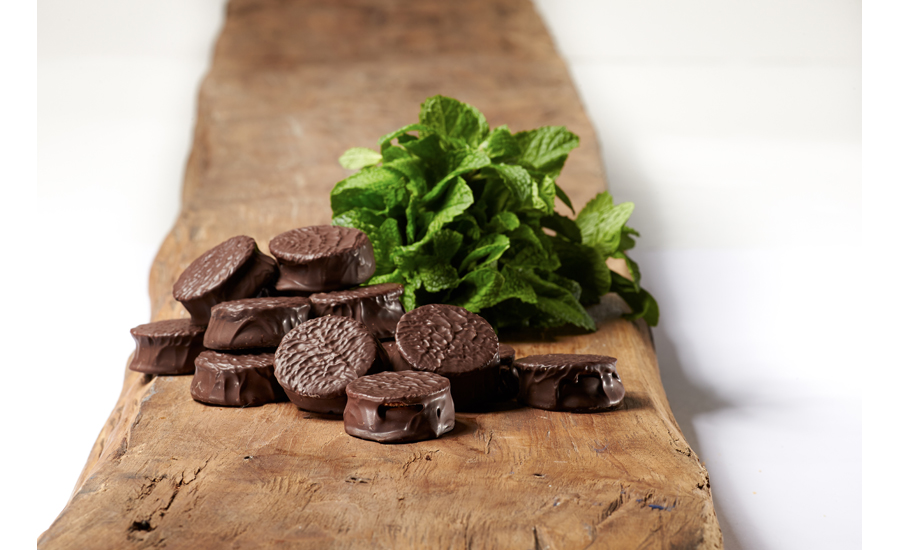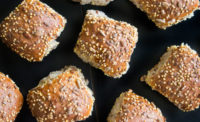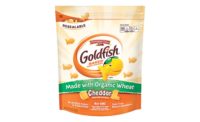In the 52 weeks ending Aug. 9, 2015, market shares of cookies and crackers reached $7.87 billion and $7.3 billion, respectively, reports IRI, Chicago. Indeed, according to data from Mintel, total U.S. retail sales of cookies and crackers grew 17 percent and 19 percent, respectively, between 2008 and 2013.
“Product innovation, including the expansion of health-focused options that allow for ‘less guilt,’ help to fuel this growth,” says Yusuke Hiraiwa, manager of industrial business and research development, Kikkoman Sales USA, Inc., San Francisco. “Both categories are expected to grow through 2018 due to continued product innovation and consumer interest in ‘healthful’ snacking options.”
Cookies come clean
The consumer trend driving growth in the cookie category is, undoubtedly, clean label. “Today’s consumer is educated and conscientious,” says Joanne Adirim, founder, CEO and executive pastry chef, HannahMax Baking, Gardena, CA. “They read labels, and they care about what they eat. They want to eat products that are made with good ingredients—names you can pronounce—and, of course, they want them to taste good, too. And they still want an indulgent cookie with simple ingredients.”
To meet consumer demand for a clean-label alternative, HannahMax developed its Cookie Chips to have just 120–130 calories per serving and contain no trans fats, GMOs, artificial flavors or colors, or preservatives. And, since gluten-free is also folded into this trend, select Cookie Chips products are made with gluten-free, whole-grain oats.
To appeal to more-adventurous flavor-seekers, HannahMax recently launched limited-edition flavors inspired by the holidays—but with a twist. Gingered Gingerbread combines tried-and-true molasses and cane brown sugar with chewy bits of crystallized ginger from Fiji; Harvest Pumpkin with Roasted Pepitas enhances pumpkin pie spice mainstays with bits of crushed pumpkin seeds known in Mexico as pepita de calabaza.
Clean label is also top of mind at ARYZTA, Los Angeles, which is preparing to launch a line of Otis Spunkmeyer foods in early 2016 carrying a “No Funky Stuff” seal, indicating the products are made with real butter, oils, fruits, chocolate and other ingredients. The new retail products will include cookies, described by Kristina Dermody, brand president, ARYZTA, as “traditional favorites that people look for at retail, but with an updated twist.”
Beyond ingredient profiles, says Dermody, small-bite options are also taking the market by storm. “People can indulge and know the calories behind a guilty pleasure, as well as have on-the-go options,” she says.
At HomeFree, LLC, Windham, NH, clean-label and bite-size trends meet in the newly released Lemon Burst Mini Cookies and Chocolate Mint Mini Cookies. “Both are free from the most-common eight allergens and gluten and, like all of our products, are also Non-GMO Verified, kosher pareve, vegan and a certified good source of whole grain,” explains president and founder Jill Robbins. “These flavors are available in 5-ounce retail boxes, as well as single-serve for grab-and-go.”

On the production line
Equipment is always a factor with clean-label—as well as allergen-free—products due to the need for impeccably clean, highly sanitary lines before running them. “Equipment cleaning time challenges all food manufacturers,” says Jim Mueller, sales territory manager, DynaClean Conveyor Corp., Muskegon, MI. He notes that tool-less disassembly and assembly saves time and resources, translating into quick changeovers that enable longer product run times and higher profits.
“Without a doubt, converting household staples to clean label is driving renewed growth in cookies and crackers,” says David Moline, sales and marketing manager, Moline Machinery, Duluth, MN.
In terms of ingredients, this translates into a desire for better toppings: Dispensing all-natural alternatives―think real fruits, dehydrated fruits, nuts and herbs―can be challenging, since they’re inherently inconsistent. Moline suggests versatile toppers that can help cookie and cracker brands dispense “everything from fine salts to large chocolate chips and everything in between,” he says.
Dow AgroSciences, Indianapolis, recently released omega-9 oils, which can clean up ingredient lists in two ways: First, they replace the functionality of partial hydrogenation; second, since the oils are naturally stable, they remove the need for synthetic additives. “Omega-9 oils are combined with other natural fats, such as palm oil fractions, to make low-saturated-fat, no-trans-fat bakery shortenings,” explains Mary LaGuardia, market manager, Dow AgroSciences. “These shortenings can reduce saturated fat in cookies by more than 50 percent, and omega-9 oils are available Non-GMO Project Verified.”
Fiber is also a factor. FiberStar, River Falls, WI, recently released a non-GMO, all-natural fiber derived from citrus designed to replace pectin while boosting fiber levels. The gelling agent is gluten-free and not sensitive to pre-gelation. It’s also stable to heat, low pH-stable and retort.
In the mix
Some shoppers today seek freshness above all other factors, even if it means sacrificing a bit of convenience. Leadership at Among Friends Baking Mixes, Ann Arbor, MI, believes the best is yet to come for cookie baking mixes, which compete with their ready-made counterparts by, well, not exactly competing with them.
“At the start of our business, we talked about Among Friends as enabling an experience as much as selling a product,” says Lizann Anderson, co-founder, Among Friends Baking Mixes. “We wanted other time-pressed folks to be able to turn out scratch-quality baked goods packed with flavor and whole-grain nutrition at a moment’s notice. We believe that there are some people who want to pull fresh-baked cookies out of the oven and aren't looking for ready-to-eat cookies, so I never felt we had to compete in that space.”
Of course, what consumers want from their ready-to-eat cookies also applies to their baked-at-home options, so Among Friends converted its entire line to gluten-free and whole grain. “We understand that cookies aren’t kale,” says Suzie Miller, co-founder, Among Friends Baking Mixes. “They are treats, but that doesn’t mean they have to be filled with unhealthy ingredients and additives.”
Among Friends’ better-for-you ingredient profile features whole grains to give busy moms the gratification of whole-grain, gluten-free baking at home, while also appealing to the whole family―“not just the ones who ‘have’ to eat them,” says Miller.

Crackers get healthy
Jim Breen, founder and CEO of Live Better Brands and Way Better Snacks, Minneapolis, agrees that consumers are much more aware of what’s in their food and looking for better-for-you ingredients that are non-GMO and of the highest quality. “Snacking now makes up about half of eating occasions, so those same healthy requirements are being applied to snack foods, too,” he says. “This has led to a boom in better-for-you snacking. We see many brands trying to balance demand for healthful ingredients, while maintaining great flavor.”
In 2015, Way Better Snacks launched sprouted barley crackers using 100 percent whole grains and non-GMO ingredients. To meet flavor demands, the crackers are available in four varieties: Rosemarry Me and Olive Oil (one serving of this variety packs in 21 grams of whole grains and 4 grams of fiber), Beyond the Sea Salt and Cracked Pepper, Back in Black Bean and Salsa, and Mustard and Cheddar Way Better.
Health demands are also gaining mindshare at the Biscuit & Cracker Manufacturers Association (B&CMA), Columbia, MD, where David Van Laar, president, says niche brands are catering to trends with specialty, nonfried snacks. And as they gain popularity with shoppers, more of these smaller niche brands are looking to up their capacity.
“In the B&CMA office, we are receiving an average of two calls per week from entrepreneurs looking for contract manufacturers,” says Van Laar. When those entrepreneurs have highly specialized products and ingredients, this search can pose challenges. He anticipates that the supply side will quickly catch up, though, as many cracker lines in the U.S. will start showing their age in the coming years and require new installations, opening up new capabilities for handling a wider range of products and ingredients.
Going forward, cracker trends will continue on the pathway to specialization, as Breen predicts potentially greater growth in the use of sprouted grains, beans and seeds in offerings.
Hiraiwa predicts continued rise in demand for “amped up” flavors demanded by Generation Z shoppers, and cites sriracha and Thai-style chili sauce as options that can help fill manufacturers’ growing need for increased heat and unique flavors.
But despite today’s desire for better-for-you and flavor-forward offerings, traditional products will continue to maintain appeal. Hiraiwa notes that the main focus for the company’s manufacturing clients is on “families with children, as these households are purchasing the full spectrum of cookies and crackers, from traditional to health-focused,” he concludes. “This phenomenon has been backed up by research that has found that two-thirds of cookie buyers and seven in 10 cracker buyers consider health attributes in their purchase decision.”
Today, manufacturers with just the right mix of tradition and adventure just might hit the sweet spot in terms of generating widespread cookie and cracker appeal.

Retail Bakery Spotlight
Alfajores emerging
The alfajor has begun to gain new levels of traction across the U.S. Bakeries across the country have begun offering widely varying versions of the South American cookies—and it doesn’t hurt that they’re a favorite of Pope Francis, who was presented gifts of the treats during his recent visit to the U.S.
Retail and wholesale bakery Wooden Table Baking, Oakland, CA, specializes in Argentinian alfajores, and has seen increased demand in recent months. Andreas Ozzuna, owner and head baker, Wooden Table Baking, provides some insight into the history and nuances of the cookies.
Douglas J. Peckenpaugh: What are alfajores?
Andreas Ozzuna: They are a traditional South American treat—two shortbread-like cookies joined with dulce de leche. They come in different flavors; the most traditional is vanilla. Then there are alfajores that are dipped in chocolate or glazed in meringue.
DJP: What is unique about Argentinian alfajores compared to other versions?
AO: With traditional Argentinian alfajores, we roll them in grated coconut. Other countries such as Peru put powdered sugar on top of the cookies, and they don’t use coconut.
DJP: How did you come to the decision that you wanted to exclusively focus on baking alfajores?
AO: I missed them! Growing up in Argentina, we ate alfajores every day. It’s a powerful need.
DJP: How did you break out of the local market to achieve distribution of your products outside of California?
AO: In 2012, we were accepted into Whole Foods locally. They introduced us to Tony’s Fine Foods, a large, regional distributor they use. Thanks to Whole Foods and Tony’s, we have gotten into more regions and worked with a national distributor, UNFI.
Also, we’ve participated in the annual Fancy Food Show in San Francisco for the past several years. We get to meet, greet and eat with representatives of distributors and specialty markets from all over the country. We get our product in their mouths, which helps. Our representation in numerous markets, also helps show potential distributors the strength of our product.
DJP: How do you decide upon the flavors you use in your alfajores?
AO: We started with the most traditional flavors of meringue, chocolate and maicena (our “traditional” flavor), so we could focus on getting the alfajor basics right—the right ingredients, texture and baking processes. Building on our success, we added other flavors over time, ones we ourselves want to eat, such as espresso chocolate (I seriously love coffee), pumpkin spice and peppermint. Sometimes, we cater to North American tastes and traditions. For example, we came up with an idea for a churro alfajor, but decided on snickerdoodle instead (with practically the same ingredients), because more North Americans would likely be able to relate to it.
DJP: What’s the next step in growing your business?
AO: Wooden Table Baking is very busy at the moment, finishing up our brand new kitchen, which will double our production space and make it much easier to keep up with demand. Once that’s up and running, likely by December of this year, we’ll keep focusing on expanding to other parts of the country and having a larger retail presence. And, of course, as baker, I’m always experimenting in the kitchen with new flavors and possible products.





